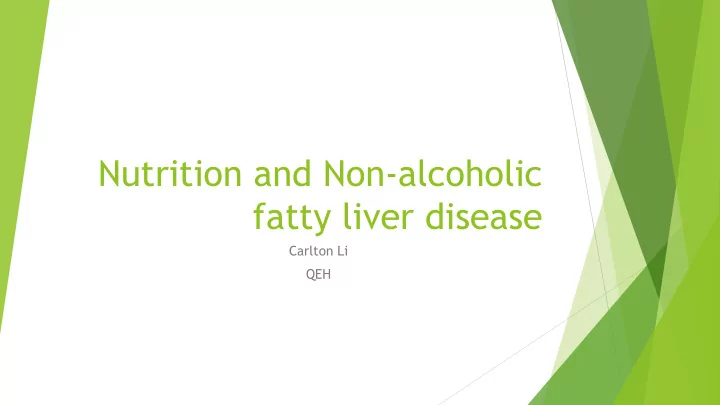

Nutrition and Non-alcoholic fatty liver disease Carlton Li QEH
Definition 1) Evidence of hepatic steatosis, either by imaging or histology 2) Lack of secondary causes of hepatic fat accumulation NAFL – presence of >=5% hepatic steatosis without evidence of hepatocellular injury in the form of hepatocyte ballooning NASH – presence of >=5% hepatic steatosis and inflammation with hepatocyte injury, with or without any fibrosis
Weight loss Works Vilar-Gomez et al. Gastroenterology 2015
Atherosclerosis 2015 Apr;239(2):483-95
Hypothesis u IRS hypothesis u ER stress hypothesis u mTORC1 hypothesis
Biochemical changes in liver cells u Overexpress SREBP-1c u Increase in expression of genes encoding fatty acid synthase and acetyl-coA carboxylase (lipogenic enzymes) Clin Sci (Lond) 120(6):239-250 Hepatol Res 38(11):1122-1129
Both carbohydrates and fat contribute to fatty liver
Nutritional induction of NAFLD Overnutrition is the primary driver Increased energy uptake supports hepatic fat accumulation by delivery of - excess fat and carbohydrates-> de-novo-lipogenesis Expansion of adipose tissue, if compounded with inflammation-> increase in - nonesterified fatty acids pool in the serum
A calorie is a calorie u Law of conservation of energy – energy can neither be created nor destroyed u Prevention of obesity = Eat less and exercise more?
Theories behind manipulation of macronutrients u alter overall calorie intake and expenditure u corresponding change in energy stores of the body u Alter endocrine factors that influence the propensity to accumulate body fat or direct the storage of fat to particular locations
u Dietary interventional study for 2 years u 750kcal calorie deficit u 4 groups with different composition of carbohydrate/protein/fat (HLL, MLH, MHL, LHH)
Key factors
Macronutrient composition is not a key determinant in weight loss success Adherence to the dietary protocol is more important
EASL 2016 guideline
AASLD 2018 guideline 20. Weight loss generally reduces Hepatic Steatosis, achieved either by hypocaloric diet alone or in conjunction with increased physical activity. A combination of a hypocaloric diet (daily reduction by 500-1,000 kcal) and moderate-intensity exercise is likely to provide the best likelihood of sustaining weight loss over time. CHALASANI ET AL. HEPATOLOGY , January 2018
Fructose
Fructose u Potent stimulator of de-novo-lipogenesis u Bypass the regulatory enzymes of the glycolytic pathway u Provide lipogenic precursors for lipogenesis (acetyl coA)
Mediterranean Diet
Recommendations u Intense nutritional education u Hypocaloric diet is helpful to induce weight loss u A diet with reduced simple sugar intake, especially fructose, to less than 10% of caloric intake u Mediterranean diet maybe protective against NAFLD (high intakes of fruits, nuts, vegetables, whole grain cereals, olive oil, and moderate consumption of fish, poultry, wine, and low intake of dairy, red meats, and sweets)
Recommend
More recommend